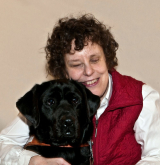All stories have an end, and at the end, all we have are stories. But for many at the end of life, these stories never leave the palliative care unit. That is where blind professional storyteller Kim Kilpatrick and mixed media artist Rachel Gray come in. As disabled artists, Kim and Rachel are uniquely attuned to the importance of bringing these stories to light in an accessible, multi-sensory way. To kick of National Palliative Care Week 2025, Kim and Rachel will share their film project, Island of Listeners.

Lexa Frail (LF): So, I'll start by asking you if you could tell us a bit about your film.
Kim Kilpatrick (KK): There's several elements to the project. I was brought on because the Isenberg lab at Bruyère Health wanted to research the benefits of storytelling on their palliative care unit. The stories we collected came from all aspects of the palliative care experience: patients, staff and caregivers. Impressively, what the research found was that it was very beneficial. Everyone seemed positive about the experience, but the stories were beautiful, and we wanted to share them and their imagery.
Rachel Gray (RG): So, we’ve created an animated film that weaves together different stories that were collected on the unit. It's done with hand painted oil animations, and one reason we chose that medium was it's very impressionistic: every mark you make leaves a trace. We thought it was an apt way to share these stories, which have so much to do with presence and absence, passing through different thresholds, and the different kinds of traces and impacts that we leave behind. Another reason why we were drawn to the oil painting animation is that it's very nonspecific. There's the idea of a figure. The figure could be many different colours. The figure could have shifting features. It's not about the specifics of who or what any one person looks like. What we're interested in is these kinds of points of connection between the stories, the different ways we can relate to these experiences. There's something archetypical about some of those stories, so we've leaned into that in the way that we've depicted them in the film.

The film is also visually described. We use the audio descriptions in our storytelling as a creative outlet as well as an accessibility feature. One reason we have this woven in is because wanted the film to be accessible to audiences in palliative care to people with different disabilities, and this act of translation is key to the project. Kim worked with the people on the unit to develop and translate their experience into stories, I translated those into visual images, and then we worked together to translate them back into text. We're really interested in what is gained through this process of translation, particularly the fact that a translation is never totally complete—it's always different.
KK: Although we gave people the choice as to how they would create their story, 99% of the time, the participants asked if I would craft it for them. I would listen and write notes, then I would make them into something. Luckily, most of the time, I could give that story back to them to make sure that I was on the right path. We were very cognizant of the amount of energy they might have, the amount of time they had to give us, and we tried to be very flexible with how we collected the stories from people. I think because we both identify as having disabilities ourselves, we really think of these factors and try to put them as front and centre as possible—which is also the palliative philosophy.
What makes this project special is that these are voices that you don't hear from. People are scared of palliative units or they don't want to think about them. So, these stories aren’t often told, and I think it's beautiful for them to be out in the world.
LF: You touched on it a bit, but I want to ask: how do disability arts and palliative care intersect?
RG: I'm more familiar with disability arts philosophy than palliative care philosophy, but I think that it's tailored to each person and their desires, versus a system that views or treats each person identically.
KK: In palliative care, it is the patient who is the boss. Good palliative care gives the patient as much agency in their treatment as possible. In a way, that's similar to how we aim to treat disability. Instead of people talking to the person with me like I’m not even there or implying that other people know better than I do, when I go on the unit, my disability seems so insignificant—not in a bad way, but I'm free there and no one questions my abilities. The staff was very open to my thoughts and questions. It's an interesting connection that we're deeply thinking about, why I felt that my disability was just taken as part of who I am instead of interrogated, like it often is in in society. I can just speculate that that's the reason, but it felt beautiful to be there. Also, my guide dog is the star on the unit. She is the one that they really want to see!
LF: Why is it so important to tell the stories from the palliative care unit? What's your biggest takeaway from this project?
RG: One reason why I was drawn to this project is that I hadn't had a lot of firsthand experience with death and dying, and I wanted to understand those experiences better. I found that there's not a lot of information out there about that. I think that it is a huge part of what it means to be alive and what it means to be human. To not speak of it, not look at it, not approach it with curiosity—it's a huge loss for all of us in understanding ourselves and in preparing us for when it inevitably enters into our lives. I found even in working with this project, I'll mention it to people and they say, “oh, that's really that's very good of you to do that. I wouldn't want to do that. It's too sad,” and that's not at all what I have found this experience to be like. The stories are so diverse: some are sad, some are moving, some are funny and they have all the different kinds of complexity that you find in life. So, I think also in not looking at these stories, not listening to these voices, it makes death only scary or only sad. It doesn't give it all space to it to exist, and I think that's really important.
This is the point that I find a little bit harder to articulate, but I think it's extremely important to look at the things that you are afraid to and that's the only path forward and that will help you figure out how to live. Without doing that, we rob ourselves of a kind of freedom or fulfillment. I hope in sharing these stories, people will feel seen, because something we find in the talks that we do is that people come to us, and they'll share right away their own experiences of being with their parents when they died or caring for somebody. It's so lonely not to have a space for that. So, I hope to give people space for sharing and connecting around those things as well as giving people information about something they might not know very much about.
KK: It struck me that there was a real urgency to their words, especially in the caregivers and patients, when they agreed to do it. They had this powerful sense of “I'm telling you these things now. You sit here and take note of them, because this is what I want to tell you,” more than if you just did it with the average person on the street. Once they agreed to do it, they were all in, and it was a brief, intense experience. They felt how meaningful it was, which I never really thought about until I did it.
What I didn't realize at the beginning was what a gift it was to present the stories. It felt special to give patients their stories back, to affirm that I heard them, that we did something. The patients were in charge. They were touched by that and I was touched, and I felt that that gift of the story and giving it back to them was a part of the process that we hadn't anticipated. It was really beautiful.
Kim Kilpatrick and Rachel Gray will present an excerpt from their film at noon, followed by a conversation with the artists. This presentation will take place at noon on May 5, 2025 at the MUHC. The film will be presented in English with English audio description and captions. Make sure you register for this workshop and other National Palliative Care Week events. For more information on this project, check out the Isenberg Lab.
